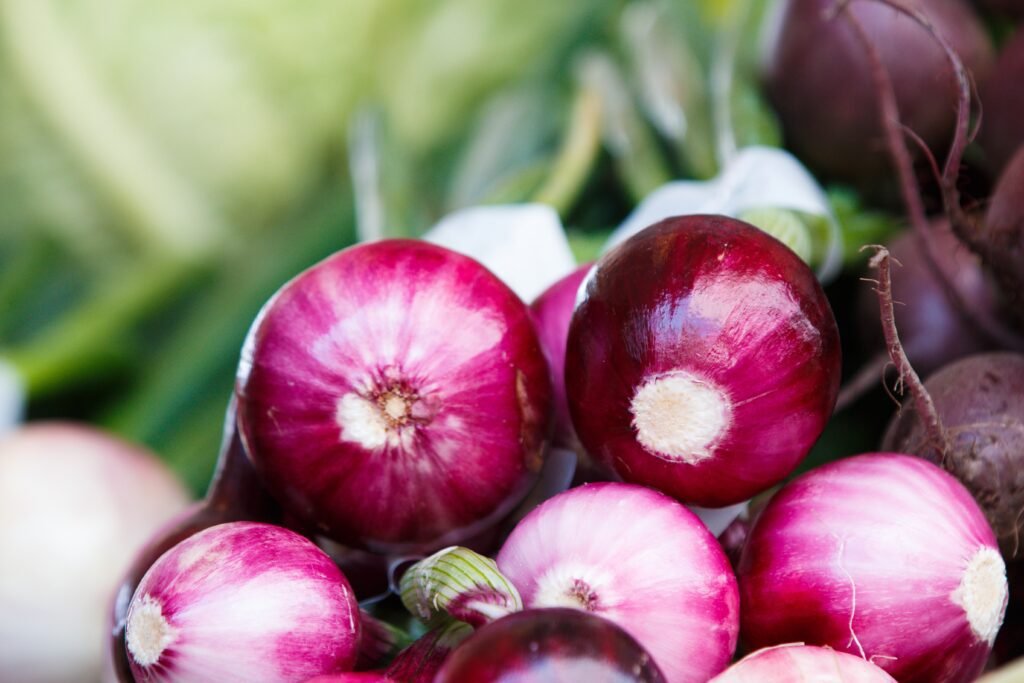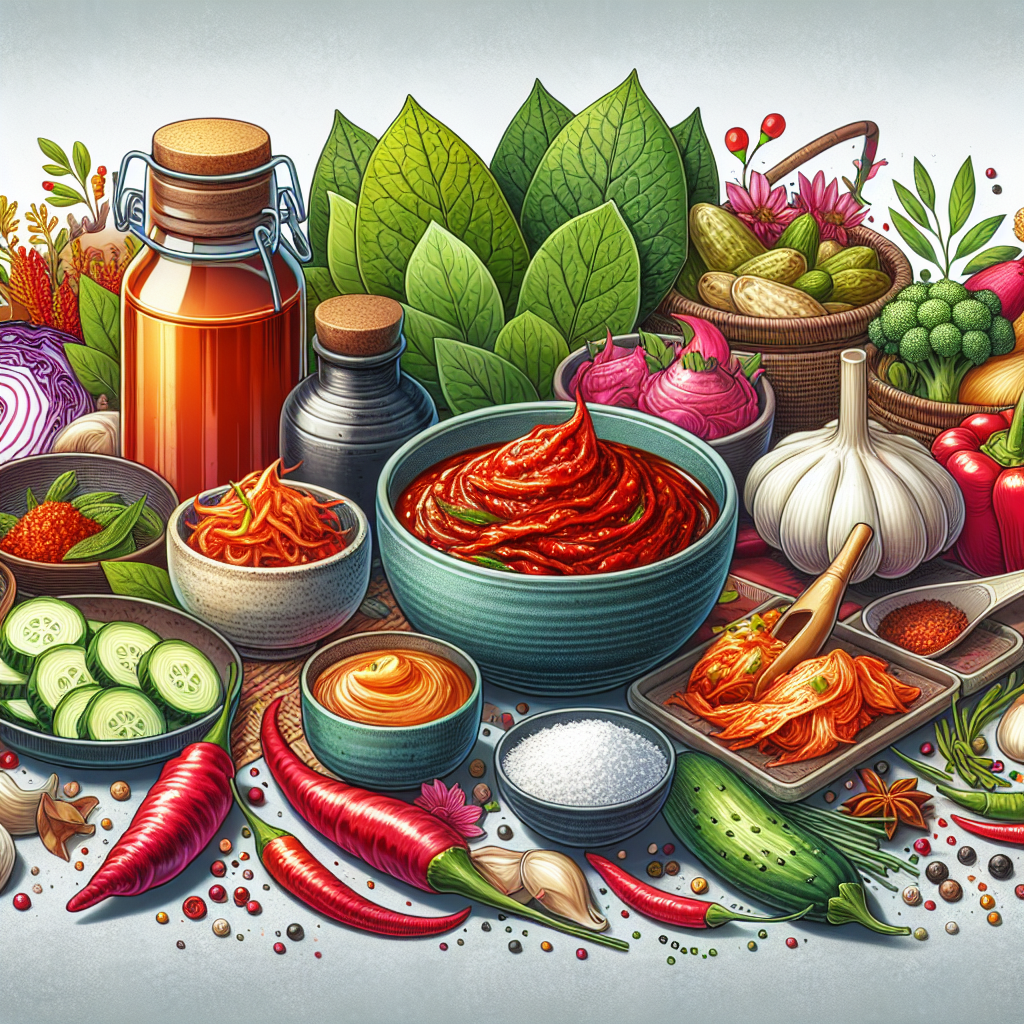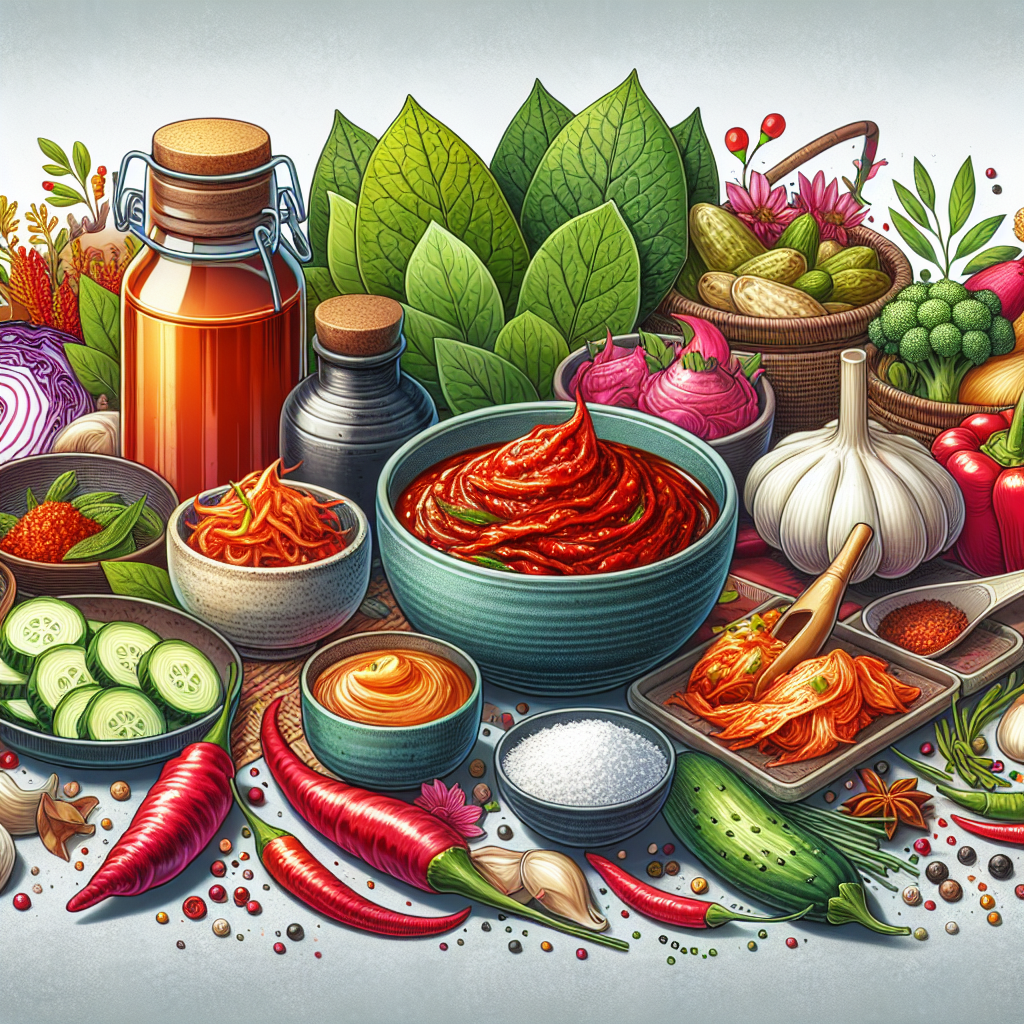Have you ever wondered what ingredients are currently making waves in Korean cooking? From spicy gochujang to tangy kimchi, Korean cuisine is known for its vibrant flavors and unique ingredients. In this article, we will explore the latest trends in Korean cooking, focusing on the popular ingredients that are taking center stage in kitchens across the globe. Get ready to tantalize your taste buds as we delve into the world of Korean cuisine and discover the exciting ingredients that are capturing the attention of food enthusiasts everywhere. Korean cuisine is known for its bold flavors and unique culinary techniques. From spicy red pepper paste to fermented kimchi, there are a variety of ingredients that are currently trending in Korean cooking. In this article, we will explore the different categories of ingredients, including spices, fermented ingredients, vegetables, seafood, noodles, snacks, rice-based dishes, meat, beverages, and herbs, and discuss some popular dishes and recipes associated with each category.

Spices
Gochujang (Red Pepper Paste)
Gochujang is a spicy and savory red pepper paste that is a staple in Korean cuisine. Made from red chili peppers, glutinous rice, fermented soybeans, and salt, gochujang adds depth and heat to dishes. It is commonly used as a marinade for grilled meats, a base for stews and soups, and as a dipping sauce for various snacks.
Doenjang (Soybean Paste)
Doenjang, also known as soybean paste, is another essential ingredient in Korean cooking. Made from fermented soybeans, doenjang has a rich and earthy flavor. It is often used as a base for soups and stews, and also as a marinade for meat and seafood dishes. The complex flavors of doenjang make it a versatile ingredient that enhances the taste of any dish.
Ssamjang (Spicy Dipping Sauce)
Ssamjang is a spicy dipping sauce that is commonly served with Korean barbecue and lettuce wraps. It is made from a combination of gochujang, doenjang, garlic, sesame oil, and other seasonings. The combination of spicy, salty, and savory flavors adds a delicious kick to grilled meats and vegetables. Ssamjang is also a popular condiment for bibimbap and other rice-based dishes.
Fermented Ingredients
Kimchi
Kimchi is a traditional Korean side dish made from fermented cabbage and radishes. It is known for its spicy and tangy flavor and is often served with rice or as an accompaniment to main dishes. Kimchi is packed with vitamins, minerals, and probiotics, making it a healthy and nutritious addition to any meal. There are many variations of kimchi, including white kimchi made without chili peppers and water kimchi made with a clear brine.
Kkakdugi (Radish Kimchi)
Kkakdugi is a type of kimchi that is made with cubed radishes instead of cabbage. It has a crunchy texture and a refreshing taste. The radishes are marinated with gochugaru (Korean red pepper flakes), garlic, ginger, and other seasonings, and then fermented to develop their flavors. Kkakdugi is commonly enjoyed with rice, as a side dish, or in stews.
Ganjang (Soy Sauce)
Ganjang, or Korean soy sauce, is a fermented sauce that is widely used in Korean cuisine. It is made from soybeans and wheat that are fermented with salt and water. Ganjang has a rich and savory flavor and is used as a seasoning in various dishes, including soups, stews, and stir-fries. It is also often mixed with other ingredients to make dipping sauces and marinades.

Vegetables
Perilla Leaves
Perilla leaves, also known as sesame leaves or kkaennip in Korean, are a popular herb used in Korean cooking. They have a distinct taste and aroma, with a combination of mint and basil flavors. Perilla leaves are often used as a wrap for grilled meats or as a topping for bibimbap and other rice dishes. They can also be stir-fried or used to make kimchi.
Korean Chili Pepper
Korean chili pepper, known as gochugaru, is a staple ingredient in Korean cuisine. It is made from dried and ground red chili peppers and has a vibrant red color. Gochugaru adds heat and flavor to dishes without overwhelming the palate. It is commonly used in kimchi, soups, stews, and stir-fried dishes. Gochugaru is also an essential ingredient in making gochujang, the famous red pepper paste.
Fernbrake
Fernbrake, also known as bracken fern, is a type of edible fern that is commonly used in Korean cuisine. It has a slightly crunchy texture and a mild and earthy flavor. Fernbrake is often blanched and seasoned with soy sauce, sesame oil, and garlic to make a delicious side dish. It is also used in soups, stews, and pancakes.
Seafood
Samgyeopsal (Pork Belly)
Samgyeopsal is a popular Korean dish made with thick slices of pork belly. It is typically grilled at the table and enjoyed with various condiments and side dishes. The fatty and tender meat of pork belly, combined with the smoky flavor from grilling, makes samgyeopsal a favorite among Koreans. It is often wrapped in lettuce leaves with ssamjang, garlic, and other toppings.
Gyeranjjim (Steamed Egg)
Gyeranjjim is a Korean-style steamed egg dish that is simple yet delicious. It is made by whisking eggs with water or broth, seasoning it with salt or soy sauce, and then steaming until set. Gyeranjjim has a smooth and custard-like texture and is often enjoyed as a side dish or as a topping for rice.
Bindaetteok (Mung Bean Pancake)
Bindaetteok is a savory pancake made with ground mung beans, vegetables, and meat or seafood. It is a popular street food in Korea, often served with a soy dipping sauce. Bindaetteok has a crispy exterior and a soft and chewy interior. The combination of flavors and textures makes it a satisfying and flavorful snack or appetizer.

Noodles
Japchae (Stir-Fried Noodles)
Japchae is a classic Korean dish made with sweet potato glass noodles, stir-fried with vegetables, meat, and a soy-based sauce. It is a colorful and flavorful dish that can be enjoyed as a main course or as a side dish. Japchae is known for its chewy noodles, colorful vegetables, and savory and slightly sweet flavors.
Bibim Guksu (Spicy Cold Noodles)
Bibim Guksu is a refreshing and spicy cold noodle dish that is perfect for hot summer days. It is made with thin wheat noodles, tossed in a spicy sauce made with gochujang, soy sauce, vinegar, and other seasonings. Bibim Guksu is typically garnished with fresh vegetables, such as cucumber, carrot, and sprouts, and topped with a boiled egg.
Naengmyeon (Cold Noodles)
Naengmyeon is a Korean noodle dish served in a chilled broth with various toppings. There are two main types of naengmyeon: mul naengmyeon, which is served in a refreshing beef broth, and bibim naengmyeon, which is served in a spicy sauce. Naengmyeon noodles are made from buckwheat flour and have a chewy and slightly nutty texture. The combination of cold noodles, flavorful broth, and toppings like sliced cucumber and beef make naengmyeon a popular summer dish.
Snacks
Bungeoppang (Fish-Shaped Pastry)
Bungeoppang is a popular street food in Korea, especially during the winter months. It is a pastry shaped like a fish and filled with sweet red bean paste. Bungeoppang has a crispy exterior and a soft and sweet filling. It is often enjoyed as a warm and comforting treat during cold weather.
Hotteok (Sweet Pancake)
Hotteok is a sweet pancake that is filled with a mixture of brown sugar, cinnamon, and chopped nuts. It is a popular snack in Korea, often sold by street vendors. Hotteok has a crispy exterior and a gooey and sweet filling. It is best enjoyed fresh off the griddle, when the filling is still warm and melted.
Seaweed Snacks
Seaweed snacks, also known as gim, are thin sheets of roasted and seasoned seaweed. They are a popular snack in Korea, enjoyed for their crispy texture and savory flavor. Seaweed snacks are often seasoned with sesame oil, salt, and other spices. They can be eaten as a standalone snack or used as a topping for rice or other dishes.

Rice-based Dishes
Bibimbap (Mixed Rice)
Bibimbap is a popular Korean dish made with mixed rice, assorted vegetables, meat, and gochujang sauce. It is a visually appealing dish, with vibrant colors from the different vegetables. The ingredients are arranged in a bowl and topped with a fried egg. Bibimbap is typically served with a side of kimchi and is enjoyed by mixing all the ingredients together to create a harmonious blend of flavors.
Kimchi Fried Rice
Kimchi fried rice, or kimchi bokkeum bap, is a delicious and easy-to-make dish that is perfect for using leftover rice and kimchi. It is made by stir-frying rice with kimchi, gochujang, and other seasonings. The result is a flavorful and spicy dish that can be enjoyed on its own or as a side dish with grilled meats or fried eggs.
Jumeokbap (Fist Rice Balls)
Jumeokbap is a Korean dish made with rice balls that are shaped by hand and formed into small fist-sized balls. The rice balls are usually mixed with various ingredients, such as vegetables, meat, and seasonings, to add flavor and texture. Jumeokbap is commonly enjoyed as a portable snack or as a lunchbox item. It is a versatile dish that can be customized according to individual preferences.
Meat
Bulgogi (Marinated Beef)
Bulgogi is a popular Korean dish made with thinly sliced beef that is marinated in a sweet and savory sauce. The beef is typically grilled or stir-fried and served with rice or wrapped in lettuce leaves with ssamjang. Bulgogi has a rich and tender texture, with a delicious combination of sweet and savory flavors. It is a versatile dish that can be enjoyed as a main course or used as a filling for sandwiches and wraps.
Dakgalbi (Spicy Grilled Chicken)
Dakgalbi is a spicy grilled chicken dish that originated in the city of Chuncheon, Korea. It is made by marinating chicken pieces in a spicy sauce made with gochujang, garlic, soy sauce, and other seasonings. The marinated chicken is then grilled or stir-fried with vegetables, such as cabbage, sweet potatoes, and onions. Dakgalbi has a spicy and flavorful taste, with a perfect balance of heat and sweetness.
Galbi (Marinated Short Ribs)
Galbi, also known as Korean barbecue short ribs, is a popular meat dish in Korea. It is made by marinating beef short ribs in a sweet and savory sauce made with soy sauce, garlic, ginger, and other ingredients. The marinated short ribs are usually grilled or broiled to perfection and served with rice, ssamjang, and various side dishes. Galbi has a tender and juicy texture, with a delicious caramelized crust from the marinade.

Beverages
Makgeolli (Traditional Rice Wine)
Makgeolli is a traditional Korean rice wine that has a milky and slightly sweet taste. It is made by fermenting rice with nuruk, a fermentation starter. Makgeolli is known for its cloudy appearance and low alcohol content. It is often enjoyed with savory snacks or as an accompaniment to Korean barbecue. Makgeolli is also used in cooking, such as in making batter for pancakes and in marinades.
Sujeonggwa (Persimmon Punch)
Sujeonggwa is a traditional Korean punch made with persimmons, cinnamon, ginger, and other spices. It is a sweet and refreshing beverage that is often served as a dessert or at special occasions. Sujeonggwa is typically enjoyed cold and is known for its soothing and aromatic flavors. It can also be served hot during the winter months.
Sikhye (Sweet Rice Punch)
Sikhye is a traditional Korean sweet rice punch that is made by fermenting cooked rice with malted barley or rice malt. It has a sweet and slightly malty flavor and is often served as a dessert or as a refreshing drink. Sikhye is enjoyed cold and is known for its unique taste and pleasant texture from the cooked rice grains.
Herbs
Wild Chives
Wild chives, also known as buchu in Korean, are a type of herb that is widely used in Korean cuisine. They have a mild and onion-like flavor and are often used as a garnish or seasoning in various dishes. Wild chives can be used fresh or dried and are commonly added to soups, stews, stir-fries, and savory pancakes.
Ginseng
Ginseng is a medicinal herb that is highly valued in Korean culture and cuisine. It is known for its healing properties and is believed to boost energy and improve overall health. Ginseng is often used in traditional herbal medicines and is also used as an ingredient in teas, soups, and other dishes. It has a slightly bitter and earthy taste.
Gosari (Fiddlehead Ferns)
Gosari, or fiddlehead ferns, are a type of vegetable that is commonly used in Korean cuisine. They have a unique spiral shape and a crunchy texture. Gosari is typically blanched and then stir-fried or added to soups and stews. It has a slightly bitter and nutty flavor that pairs well with other ingredients. Gosari is often enjoyed for its nutritional benefits, including high levels of antioxidants and fiber.
In conclusion, Korean cuisine boasts a wide variety of trending ingredients that add depth, flavor, and complexity to traditional dishes. From the bold spiciness of gochujang and the umami richness of doenjang to the crispness of Korean chili peppers and the refreshing taste of perilla leaves, these ingredients play an integral role in creating the unique flavors of Korean cooking. Whether you’re exploring the world of Korean cuisine for the first time or are already a fan, incorporating these trending ingredients into your dishes will elevate your culinary experience and transport you to the vibrant streets of Korea. So go ahead and explore the world of Korean cooking, one delicious ingredient at a time.
